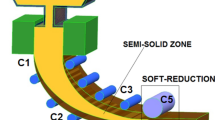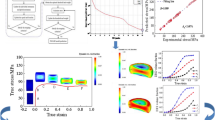Abstract
Calculation of the properties of low- and moderate-alloy structural steel is possible by modeling the decomposition kinetics of supercooled austenite at constant temperature and in continuous cooling. A model for predicting the microstructure of steel is derived by means of an artificial neural network of GRNN type. Calculation of the hardenability curve on the basis of microstructural modeling is described.
Similar content being viewed by others
References
Kachanov, N.N., Prokalivaemost’ stali (Hardenability of Steel), Moscow: Metallurgiya, 1978.
Popov, A.A. and Popova, L.E., Diagrammy prevrashcheniya austenita v stalyakh i beta-rastvora v splavakh titana. Spravochnik termista (Decomposition Diagrams of Austenite in Steels and Beta Solutions in Titanium Alloys: A Thermal Handbook), Moscow: Metallurgiya, 1991.
Nemchinskii, A.L., Teplovye rashchety termicheskoi obrabotki (Thermal Calculations of Heat Treatment), Moscow: SudpromGIZ, 1953.
Handbook of Thermal Process Modeling of Steel, Pan, J., Ed., London: Taylor & Francis, 2009.
Fachinotti, V., Cardona, A., and Anca, A., Solid-State Microstructure Evolution in Steels, Mechan. Comp., 2005, vol. 24, pp. 901–914.
Smoljan, B., Smokvina, H.S., Tomašić, N., and Iljkić, D., Computer Simulation of Microstructure Transformation in Heat Treatment Processes, J. Achievements Mater. Manuf. Eng., 2007, vol. 24,issue 1, pp. 275–282.
Dobrzan-ski, L.A., Malara, S., and Traska, J., Project of Computer Program for Designing the Steel with Assumed CCT Diagram, J. Achievements Mater. Manuf. Eng., 2007, vol. 20,issue 1–2, pp. 351–354.
Yescas, M.A., Prediction of the Vickers Hardness in Austempered Ductile Irons Using Neural Networks, Int. J. Cast Metals Res., 2003, vol. 15, pp. 513–521.
Trzaska, J., Jagiello, A., and Dobrzańskii, L.A., The Calculation of CCT Diagrams for Engineering Steels, Arch. Mater. Sci. Eng., 2000, vol. 39, pp. 13–20.
Saunders, N., Guo, Z., Li, X., Miodownik, A.P., and Shille, J.-P., The Calculation of TTT and CTT Diagrams for General Steels, Mater. Sci. Technol., 2002, vol. 18, pp. 861–863.
Chen, I., Xia, W., and Chen, X.J., Development of Computer Simulation Software on Phase Transformation during Quenching, Acta Metall. Sin., 2000, vol. 13, no. 2, pp. 618–622.
Umemoto, M., Nishioka, N., and Tamura, I., Prediction of Hardenability from Isothermal Transformation Diagrams, Trans. ISIJ, 1982, vol. 22, pp. 629–636.
Specht, D.S., A General Regression Neural Network, IEEE Trans. Neural Net., 1991, vol. 2, no. 6, pp. 568–576.
Duzgun, R., Generalized Regression Neural Networks for Inflation Forecasting, Int. Res. J. Fin. Econ., 2010, issue 51, pp. 59–70.
Author information
Authors and Affiliations
Additional information
Original Russian Text © A.A. Rifel’, 2013, published in “Stal’,” 2013, No. 3, pp. 58–61.
About this article
Cite this article
Rifel’, A.A. Predicting the hardenability of structural steel on the basis of the decomposition kinetics of supercooled austenite. Steel Transl. 43, 148–151 (2013). https://doi.org/10.3103/S0967091213030108
Published:
Issue Date:
DOI: https://doi.org/10.3103/S0967091213030108




